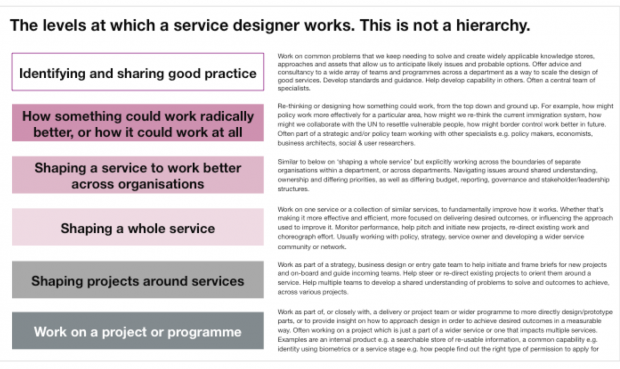Many services (as end users would know them) transcend teams, directorates, organisations or departments. It’s not obvious where service designers should sit, since we want them to be working on services which by nature don’t always fit current organisation structures.
There are a few approaches to choose from, including:
- having service designers sit within or across a few delivery teams, which are usually part of the digital, data and technology organisation within a large department
- embedding with the strategy teams of large operational areas who control change budgets
- working with policy and offering specialist skill sets to help think through problems, develop shared understanding of potential user journeys or help shape what the problem is to solve
- sitting within operations and joining forces with user research, customer insight and continuous improvement teams to help improve service delivery behind the scenes and on the front line
- supporting more centralised strategy teams, often those taking a more systemic view across multiple organisations, wider strategy, transformation and change directorates
We’ve seen the pros and cons of each of these approaches. The Home Office now has a more federated model. Rather than try to find the right existing team, we set out the different levels at which a service designer can do useful and valuable work to define, manage, design or scale services.
We can then find the closest match with an existing group of people or organisational entity that would identify with the problems that we’re well placed to help solve at that level.
Likely problems include:
- not knowing if all the work we’re doing is cohesively making things better in a measurable way
- teams not aligned around a shared understanding of desired outcomes or consistent measures of performance
- a disconnect between the insights that lead to a project being funded and set up, and an incoming team to work on it
The levels service designers work at
On a project or programme
Work as part of, or closely with, a delivery or project team or wider programme to more directly design/prototype parts, or to provide insight on how to approach design to achieve desired outcomes in a measurable way. Often working on a project that’s just a part of a wider service, or one that impacts multiple services.
Examples are an internal product, such as a searchable store of reusable information; a common capability, such as identity using biometrics; or a service stage, such as how people find out the right type of permission to apply for.
Shaping projects around services
Work as part of a strategy, business design or entry gate team to help initiate and frame briefs for new projects, and on-board and guide incoming teams. Help steer or redirect existing projects to orient them around a service. Help multiple teams develop a shared understanding of problems to solve and outcomes to achieve, across various projects.
Shaping a whole service
Work on one service or a collection of similar services to fundamentally improve how it works. Whether that’s making it more effective and efficient, more focused on delivering desired outcomes, or influencing the approach used to improve it. Monitor performance, help pitch and initiate new projects, redirect existing work and choreograph effort. Usually working with policy, strategy, service ownership and developing a wider service community or network.
Shaping a service to work better across organisations
Similar to ‘shaping a whole service’ but explicitly working across the boundaries of separate organisations within a department, or across departments. Navigating issues around shared understanding, ownership and differing priorities, as well as differing budget, reporting, governance and stakeholder/leadership structures. The cross-government service community work on ‘start a business’ is a good example of this.
How something could work radically better
Rethinking or redesigning how something could work, from the top down and ground up. For example, how might policy work more effectively for a particular area? How might we rethink the current immigration system? How might border control work better in future? Often part of a strategic and/or policy team working with other specialists such as policy makers, economists, business architects, and social and user researchers.
Identifying and sharing good practice
Work on common problems that we keep needing to solve. Create widely applicable knowledge stores, approaches and assets that allow us to anticipate likely issues and probable options. Offer advice and consultancy to a wide array of teams and programmes across a department as a way to scale the design of good services. Develop standards and guidance. Help develop capability in others. Often working as part of a central team of specialists.
At the Home Office, service designers work at every level. Individuals are embedded with many different areas in the department. Yet we simultaneously keep our identity as part of a single team of service designers as well as part of a central enabling team within the digital, data and technology part of the organisation.
This ‘federation’ allows us to spot common patterns and trends that we can use to standardise and scale good approaches to services across the department, while growing the specialist domain knowledge we need to have real impact in policy, strategy, operation and delivery teams.


Leave a comment